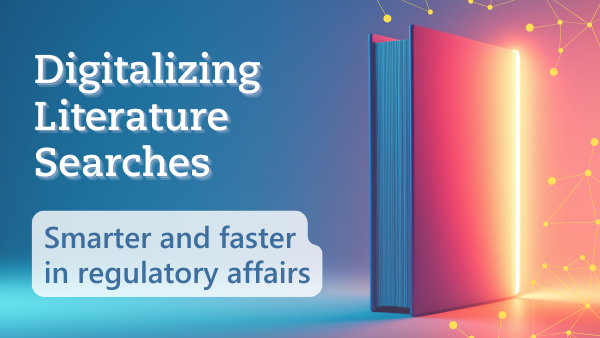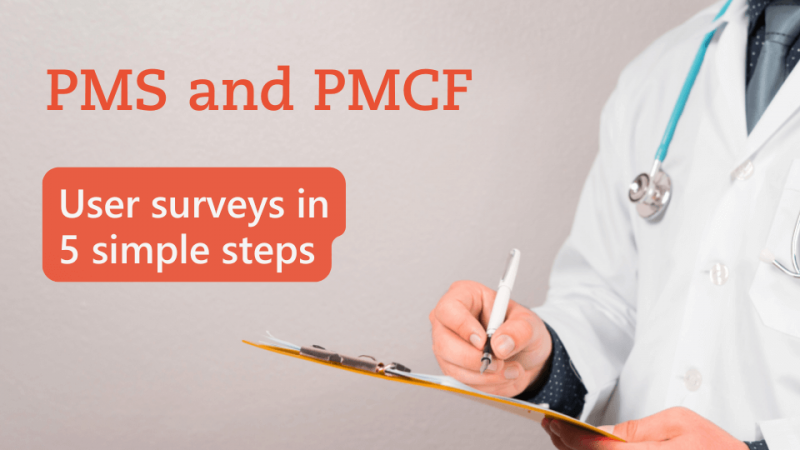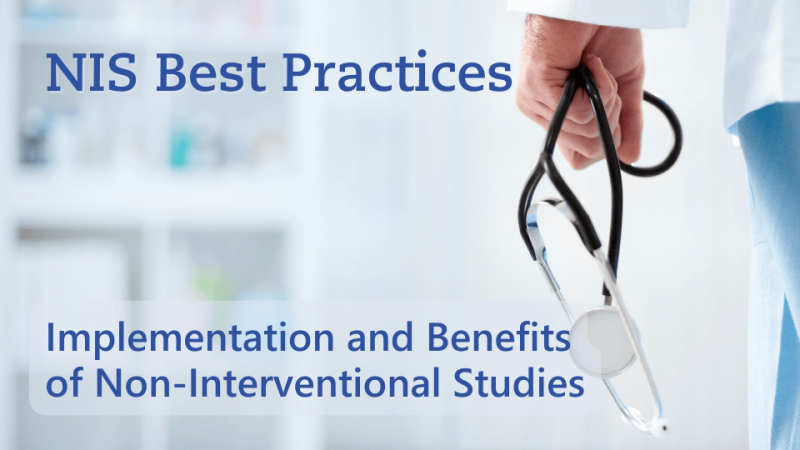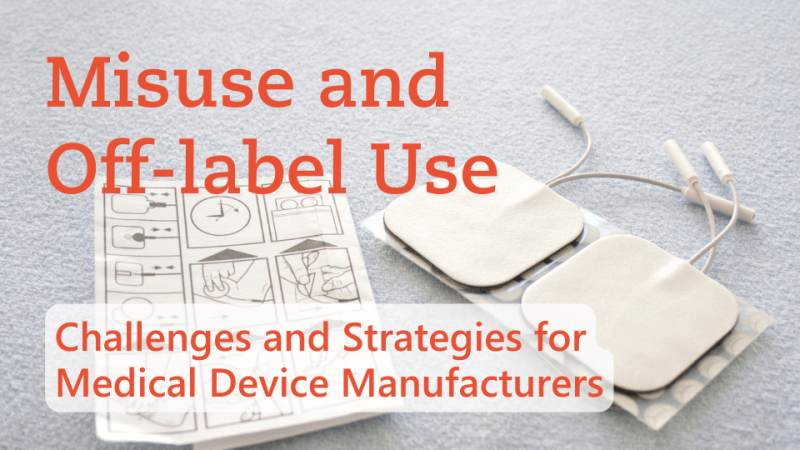Digitalizing systematic literature searches: an entry point into a smart regulatory strategy
13/10/2025
Do you have any questions about the article or would you like to find out more about our services? We look forward to hearing from you!Make a non-binding enquiry now
Few areas in Regulatory Affairs make the need for digitalization as tangible as systematic literature searches: the process is complex, manually driven, repeated regularly, and yet crucial for clinical evaluation, post-market surveillance (PMS), and the regulatory demonstration of conformity.Medical device companies therefore increasingly rely on digital solutions to streamline workflows, minimize sources of error, and conserve resources. However, choosing the right software requires more than just intuition: it is a strategic decision with far-reaching consequences and therefore a matter for senior management.
Equally important: the entire process, from screening to extraction of relevant information, should be mapped in a structured and audit-proof manner that withstands regulatory scrutiny.However, the scope of features alone does not guarantee quality. It is just as important how well the software integrates into existing processes. Solutions that require extensive training or complete process redesigns may fail in practice despite impressive functionality. The quality of support, software validation, and potential for further development should also be part of the decision.
In short: the best software is the one that fits the company's processes, goals, and resources, not necessarily the one that promises the most.
Some tools even allow users to "chat" with publications: an AI assistant proposes response formulations or appraisal statements.As promising as these functions sound, they also come with risks. It is not yet clear to what extent AI-assisted steps, such as automated screening, are acceptable from a regulatory perspective. Notified bodies tend to react cautiously, particularly when human traceability or intervention is no longer clearly ensured.Furthermore, the question arises whether AI truly saves time or whether verification and correction ultimately require additional effort.
An AI system is only as good as the data it has been trained on and only as transparent as its behavior is explainable.In our experience, AI is beneficial only when certain prerequisites are met:
The functions must be explainable and switchable, the results validatable, and users must retain control at all times. Only under these conditions can AI provide genuine support, not just in theory, but in everyday regulatory practice.
The right solution not only relieves individual employees but can also form the foundation for further digitalization, for example, within a regulatory information management system (RIMS), through automation of PMS workflows, or in improving cross-functional coordination of regulatory requirements.
Who leads the project? Who decides? And who will ultimately work with the solution? For a successful digitalization project, an interdisciplinary core team is essential, one that combines subject-matter expertise, process insight, and regulatory perspective.In addition to Clinical and Regulatory Affairs, IT, Quality Management, and, if available, digitalization or innovation leads should be involved from the start. Clearly defined project roles, communication channels, and shared objectives ensure well-founded, practical decisions and successful acceptance and implementation.Tip: Define from the outset who gathers requirements, who communicates with vendors, who evaluates, and who will later take responsibility for use and maintenance.
As a regulatory partner with broad application expertise, Metecon has the unique opportunity to engage directly with software developers – a level of access most users lack.
This open exchange allows us to bring in hands-on feedback and actively contribute to improving both software functionality and regulatory documentation.For our clients, this means: they benefit not only from our market insight but also from our direct connections to software providers and from solutions demonstrably tailored to the needs of regulatory users.We understand that introducing a software solution is not an end in itself. It must integrate smoothly into the existing system landscape, fit organizational structures and responsibilities, and be both regulatory-compliant and validated. Most importantly, it must be understood and accepted by its users.That's why we support clients not only in tool selection, but also in preparing internally for success – from process analysis and vendor communication to validation strategy and training.
Contact us for an initial, non-binding conversation.
 Sabine Schumann-Hahn
Sabine Schumann-Hahn
Why literature searches are an ideal starting point for digitalization
Systematic literature searches are excellently suited as a starting point for digital transformation in regulatory processes. They are clearly structured, highly standardized and at the same time labor-intensive to perform.Although the procedures are clearly defined (e.g. following PICO, MEDDEV 2.7/1 Rev. 4), the actual execution is very time- and resource-consuming because it:- involves many manual sub-steps (e.g. database searches, screening, appraisal, documentation)
- requires high diligence
- is repeated regularly (e.g. as part of PMS, PMCF, or re-certifications)
- often engages several people across departments (Regulatory, Clinical, Quality Management, etc.)
What good software should – and should not – do
An effective software solution for systematic literature searches should help users define search strategies according to established approaches such as the PICO model. It should provide stable connectivity to key scientific databases, ideally not only to PubMed, but also to platforms such as ClinicalTrials.gov, Cochrane Database of Systematic Reviews, EBSCO, or Embase.Equally important: the entire process, from screening to extraction of relevant information, should be mapped in a structured and audit-proof manner that withstands regulatory scrutiny.However, the scope of features alone does not guarantee quality. It is just as important how well the software integrates into existing processes. Solutions that require extensive training or complete process redesigns may fail in practice despite impressive functionality. The quality of support, software validation, and potential for further development should also be part of the decision.
In short: the best software is the one that fits the company's processes, goals, and resources, not necessarily the one that promises the most.
AI features: useful innovation or gimmick?
Many providers promote AI-based features. In practice, this may mean that a system suggests inclusion or exclusion of publications based on previous decisions, automatically generates summaries, extracts quantitative data or highlights relevant text passages in full texts.Some tools even allow users to "chat" with publications: an AI assistant proposes response formulations or appraisal statements.As promising as these functions sound, they also come with risks. It is not yet clear to what extent AI-assisted steps, such as automated screening, are acceptable from a regulatory perspective. Notified bodies tend to react cautiously, particularly when human traceability or intervention is no longer clearly ensured.Furthermore, the question arises whether AI truly saves time or whether verification and correction ultimately require additional effort.
An AI system is only as good as the data it has been trained on and only as transparent as its behavior is explainable.In our experience, AI is beneficial only when certain prerequisites are met:
The functions must be explainable and switchable, the results validatable, and users must retain control at all times. Only under these conditions can AI provide genuine support, not just in theory, but in everyday regulatory practice.
Selecting software with foresight and structure
Choosing software for systematic literature searches is more than a technical decision: it impacts the daily work of Regulatory and Clinical teams, the quality of technical documentation, and ultimately market access.A structured selection process is therefore essential.The right solution not only relieves individual employees but can also form the foundation for further digitalization, for example, within a regulatory information management system (RIMS), through automation of PMS workflows, or in improving cross-functional coordination of regulatory requirements.
Checklist: what decision-makers should consider
- Have you defined clear requirements: functional, technical, and organizational?
- Do you have reliable contact persons? Is the vendor open to feedback and further development?
- Is there a transparent validation strategy?
- Can all relevant departments and roles work with the tool?
- Which databases are connected, and how stable is the connectivity?
- How scalable is the tool with regard to other processes (e.g. RIMS)?
- Which AI features are included and how are they explained, documented, and safeguarded?
Preparing internally for success
Before software selection even begins, internal alignment is key:Who leads the project? Who decides? And who will ultimately work with the solution? For a successful digitalization project, an interdisciplinary core team is essential, one that combines subject-matter expertise, process insight, and regulatory perspective.In addition to Clinical and Regulatory Affairs, IT, Quality Management, and, if available, digitalization or innovation leads should be involved from the start. Clearly defined project roles, communication channels, and shared objectives ensure well-founded, practical decisions and successful acceptance and implementation.Tip: Define from the outset who gathers requirements, who communicates with vendors, who evaluates, and who will later take responsibility for use and maintenance.
Metecon's perspective: digitalization as a strategic lever
At Metecon, we have supported medical device companies for years in the selection and implementation of software solutions – with a clear focus on regulatory feasibility, process reliability, and strategic value.Software vendors vary in their strengths: while large companies often stand out through stability and resources, smaller providers may be more innovative and agile.As a regulatory partner with broad application expertise, Metecon has the unique opportunity to engage directly with software developers – a level of access most users lack.
This open exchange allows us to bring in hands-on feedback and actively contribute to improving both software functionality and regulatory documentation.For our clients, this means: they benefit not only from our market insight but also from our direct connections to software providers and from solutions demonstrably tailored to the needs of regulatory users.We understand that introducing a software solution is not an end in itself. It must integrate smoothly into the existing system landscape, fit organizational structures and responsibilities, and be both regulatory-compliant and validated. Most importantly, it must be understood and accepted by its users.That's why we support clients not only in tool selection, but also in preparing internally for success – from process analysis and vendor communication to validation strategy and training.
Conclusion: laying the foundation for a digital regulatory strategy
Digitalizing systematic literature searches is far more than an efficiency project. It is a practical and scalable entry point into a broader digital transformation and an opportunity to make processes more sustainable, transparent, and resilient.Those who take a strategic approach here not only reduce day-to-day workload but also establish the foundation for true regulatory intelligence with potential for AI integration, RIMS implementation, and automated compliance management.Your next step: finding the right solution with Metecon
Are you at the beginning of your digitalization journey or looking to critically assess your existing tools? We support you – from requirement analysis and vendor evaluation to successful integration – regulatorily sound, practically proven, and strategically aligned.Let's digitalize your literature search and think beyond.Contact us for an initial, non-binding conversation.
Our blog posts are researched and created with the utmost care, but are only snapshots of the regulations, which are constantly changing. We do not guarantee that older content is still current or meaningful. If you are not sure whether the article you have read on this page still corresponds to the current state of regulation, please contact us: we will quickly place your topic in the current context.

Team Lead Post-Market Surveillance



